100 Things I Hate About Views: Undeclared Data Types in Columns
By Kendra Little on March 14, 2025
Views let you do dumb things by accident in SQL Server. Then they make you have to think way too hard to fix them.
Most of the time when people create views, they start by refining a SELECT query, then turn it into a view. People also often create multiple views that pull different slices of data and UNION the results together.
Combined, these two things easily lead to undeclared datatypes in views with problematic implicit conversions.
SQL Server Lets You Define a View with Columns with Undeclared Data Types
You can even have it return a null if you’re going to UNION that view with other things.
It doesn’t look very weird at all, it just looks like this…
CREATE OR ALTER VIEW
dbo.i_am_view
AS
SELECT
some_column = NULL
/* column2,
column3
FROM dbo.Sometable, etc
*/
GO
Let’s Say We have That View, Plus a Related Table
Here’s the table and its rows:
CREATE TABLE
dbo.i_am_table
(
some_column varchar(100) NOT NULL,
last_modified_date datetime2(0) NULL
);
GO
INSERT INTO
dbo.i_am_table
(
some_column,
last_modified_date
)
VALUES
('1', '2023-01-01'),
('ONE', NULL),
(NULL, '2024-01-01'),
('', '2025-01-01');
GO
Select from the View and Union with the Table
Here’s the query
SELECT
some_column,
last_modified_date = ''
FROM dbo.i_am_view AS v
UNION
SELECT
some_column = t.some_column,
last_modified_date = t.last_modified_date
FROM dbo.i_am_table AS t
WHERE t.last_modified_date IS NOT NULL
ORDER BY
last_modified_date;
GO
The Results are Odd

Notable bits:
- Row 1 came from the view. The last_modified_date column, which was also not given a data type in our query, returned January 1, 1900– it got a magic default value.
- Row 4 has 0 as the value for some_column. This was an empty string in the table, but it’s been converted to a numeric 0.
The Query Execution Plan Explains More
Let’s look at that warning on the SELECT operator, plus that compute scalar operator after we read the table.
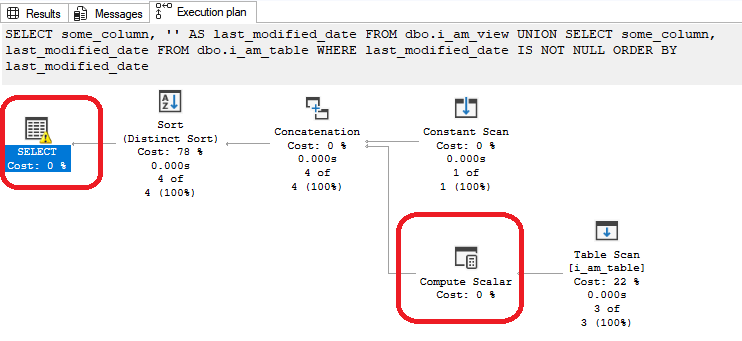
We’re Warned About an Implicit Conversion
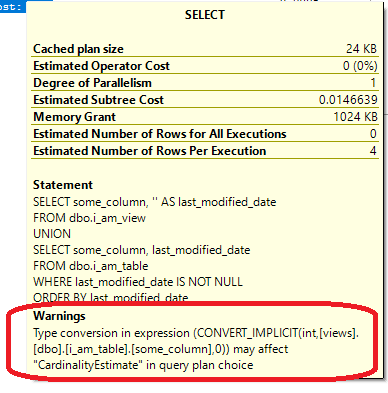
I find these messages really hard to read with the text all crammed together. Here it is with a lot of spacing added:
Type conversion IN expression (
CONVERT_IMPLICIT
(integer,
[views].[dbo].[i_am_table].[some_column]
,0)
) may affect "CardinalityEstimate" IN query plan choice
SQL Server decided that it needed to convert the some_column values in dbo.i_am_table from the datatype they are stored as– VARCHAR(100) – into the INT datatype.
Looking at the compute_scalar operator confirms this.
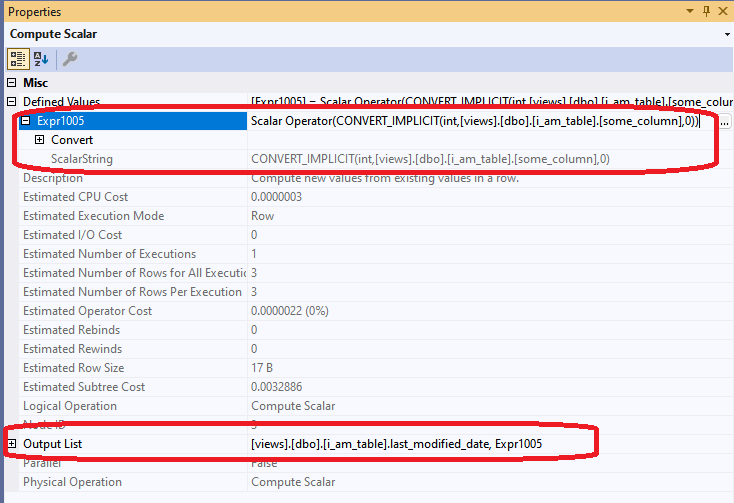
Expr1005 is defined as the result of that CONVERT_IMPLICIT function, which is converting values from some_column to integers. Expr1005 is returned from this operator along with the last_modified_date column.
If We Remove the Where Clause, the Query Fails
If we let that row where some_column has the value “one” through, the query fails with the error:
Msg 245, Level 16, State 1, Line 52 Conversion failed when converting the varchar value ‘ONE’ to data type int.
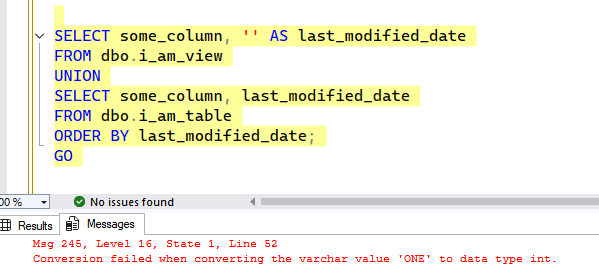
I guess we can’t implicitly convert words to integers.
Why an Integer?
When we created the view, we defined it with:
SELECT
some_column = NULL
We didn’t give SQL Server anything to go on, so it guessed int.
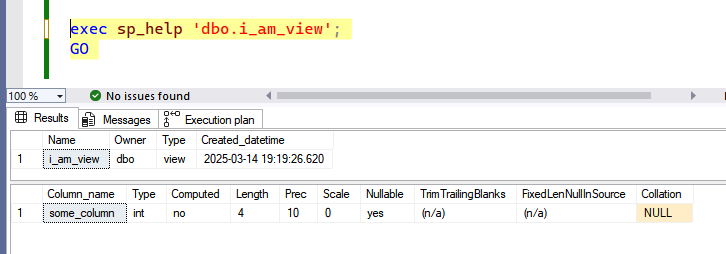
The same thing happens if we use this syntax to create a temp table.

We shouldn’t leave this to chance
I wish SQL Server wouldn’t let you create a view this way, but it does. However, we’re much better off specifying a data type, which we can do with the syntax:
CREATE OR ALTER VIEW
dbo.i_am_view
AS
SELECT
some_column = CAST(NULL AS varchar(100));
GO
This avoids errors with data type conversions, not to mention unexpected results and performance issues with type conversions.